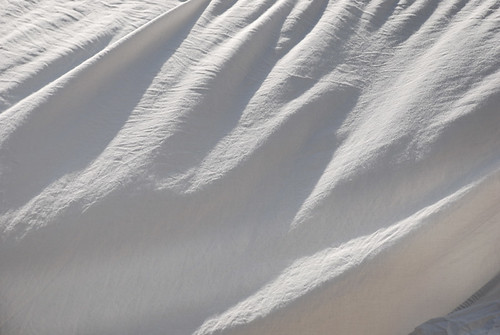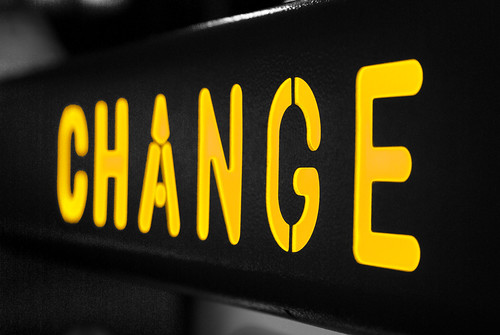 Direction of Light
Direction of LightTo get some examples in our heads before we started our experiments, here are some that show different directions from Madonna's music video 'Vouge'.
Here, you can see how the light has illuminated on Madonna's face, and this was probably done with reflectors, as she wouldn't have wanted the light in her face.
With this frame, the model has been spot lighted with a high light onto him. This is so you can clearly see him, but this also has created an eery cast shadow on the wall to the left of him.
Direction Experiment
To be able to understand how the direction of light applies in person, we conducted an experiment to show this. As a group, we used different tools to deflect the light, and use different angles to show different effects this can have on the model. We were given different tools to experiment with including
* Foil
* A white sheet
* Black wrap
Alongside these, we used equipment such as a Mini DV camera, a tripod, batteries, base plate, tape, laminated white board and marker pens, one lower pro 250w lamp, one stand, chimera and diffusion attatchments, speed ring, scissors, saftey gloves and an extention lead .
We also were to try different angles of light including side lighting, high lighting, bottom lighting and face on lighting.

* Foil

* A white sheet

* Black wrap

Alongside these, we used equipment such as a Mini DV camera, a tripod, batteries, base plate, tape, laminated white board and marker pens, one lower pro 250w lamp, one stand, chimera and diffusion attatchments, speed ring, scissors, saftey gloves and an extention lead .
We also were to try different angles of light including side lighting, high lighting, bottom lighting and face on lighting.

Before starting this experiment, we discussed what we predicted all the different tools would do. As a group, we predicted that the white sheet would make less shadows and lighten the face of the model, the black wrap wouldn't make that much difference, the foil would reflect on the person's face more and that the black wrap wouldn't make much difference.
We also thought that with just the light on the subject, depending on where it was positioned, it would produce cast shadows behind the subject, as well as on the face.
However these are mere predictions and we would find out after the experiment which ones we got right and what ones we got wrong.

The factors that we would have to measure include the effect of the tool on the model. This is the main aspect that we have to measure, as when we find out what the effect of each of the different tools have, this will help us to decide whether we need to use these tools when we film our short film.
We also thought that with just the light on the subject, depending on where it was positioned, it would produce cast shadows behind the subject, as well as on the face.
However these are mere predictions and we would find out after the experiment which ones we got right and what ones we got wrong.

The factors that we would have to measure include the effect of the tool on the model. This is the main aspect that we have to measure, as when we find out what the effect of each of the different tools have, this will help us to decide whether we need to use these tools when we film our short film.

Some of the factors we will have to change include the tools that we will be using to change the effect and direction of light as this will help us to see the range of effects they produce. However, we would need to keep the subject the same, as well as the camera position. This is so we can see the exact change in the light, and if this was changed half way through, the lighting would have changed and so would the shadows; this would be misleading and would not give us the correct information.
Our Experiment:
Conclusion
Here are some screen grabs from our experiment.
From this screen grab, you can see that there is a point in which the light starts to wonder off, and this is creeping around the subject. There is also a cast shadow behind him, and this is blocked from him. This teaches us that we need to be careful if we were to use extra light in our film as there is a point that the light becomes a shadow, and that this can cause shadows unnecessarily.
MORE EXAMPLES!!!!!!
 I feel that our experiment was very successful, as we have covered the material well and have managed to show these in detail; this did mean that our video clip was largely longer, but I think that this is better as we can see the changes clearly. I also think we kept the subject still too, as this could have been confusing if he kept moving around, and wouldn't have shown as clear the changes.
I feel that our experiment was very successful, as we have covered the material well and have managed to show these in detail; this did mean that our video clip was largely longer, but I think that this is better as we can see the changes clearly. I also think we kept the subject still too, as this could have been confusing if he kept moving around, and wouldn't have shown as clear the changes. Above all, I think we all worked together well as a group and this shows in the quality of our experiment. We managed to stay calm and work as a team. This was down to the fact that we all had small roles, and this way we did not over step each other or get in the way of one another. This also meant that we were able to concentrate on our own section and were able to do these well.
On the other hand, we could have timed out experiment better so that it wasn't as long as it was, as it was quite long to watch, even though it shows well the experiment. We could have also worked quicker, as we did take some time setting up and getting organised. This is vital as we will not have long to film our project and need to practice these skills now.
In reflection of this experiment, we will be able to take learn what is needed in order to film make the shadows less or more on the face, or even behind the subject; this would be done with a brighter light directed onto either straight onto the subject or behind them. We have also found out how to make less shadows around the face, and to make them more flattering, this would be done by using a white sheet reflected onto the face.
REPEAT the above for the other experiment to ensure you cover both "quality" and "direction".





No comments:
Post a Comment